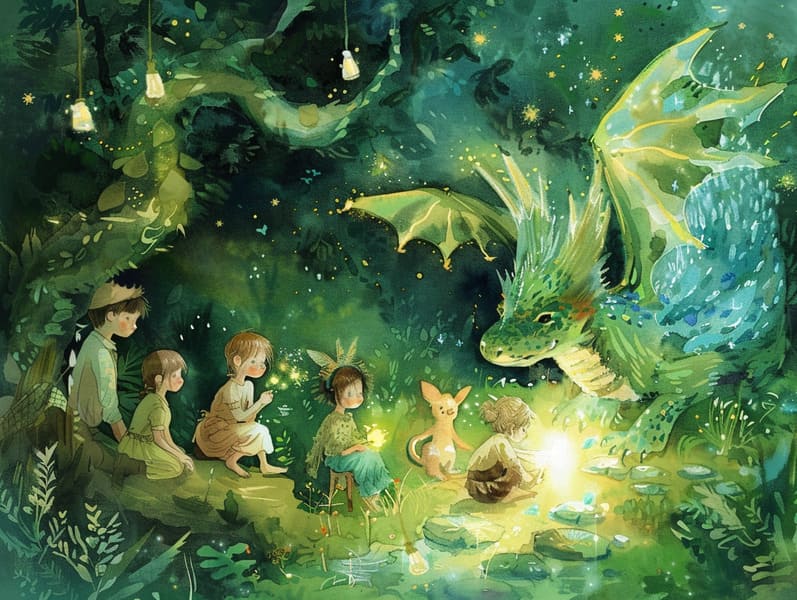Discovering the Magic of Nightfall Fables: Creating Treasured Times with Your Children
Discovering the Magic of Nightfall Fables: Creating Treasured Times with Your Children
Blog Article

Bedtime is a precious time for parents and children. It’s a opportunity to calm down, get cozy, and enjoy the wonder of stories.
For lifetimes, nightly tales for children have been a beloved practice, offering more than just a way to fall asleep. They provide an occasion for relationship building, growth, and igniting fantasy.
Why Bedtime Stories are Important
Sleep stories for kids do more than a way to complete the day. They play a vital role in a child’s development and in nurturing the caregiver-child link. Here’s why they are beneficial:
1. Closeness Moments: Bedtime reading develops a special time of affection between kids and their parents. It’s a moment of affection that helps children feel appreciated and comforted.
2. Language Skills: Listening to stories helps children develop their speech skills. They acquire new language, understand form, and boost their hearing and grasping abilities.
3. Creative Development: Kids' stories lead them to fantastic worlds, promoting imagination. They imagine characters, settings, and adventures, which sparks their innovation.
4. Feeling Recognition: Stories for little ones often include characters facing obstacles and feelings. These stories help kids grasp and deal with their own feelings, enhancing emotional maturity.
5. Thinking Skills: Engaging with a story helps children develop attention span, memory, and critical thinking skills. They enhance to follow scripts, remember components, and predict outcomes.
Integrating Bedtime Stories into Your Night
Establishing a bedtime habit that has narrating bedtime stories is simple and gratifying. Here’s how to develop a important part of your evening tradition:
1. Choose a Relaxing Place: Pick a cozy place where you and your child can nestle in without noise. A cozy bed or a snug reading nook works beautifully.
2. Choose a Specific Time: Pick a consistent time each night for reading. Uniformity helps children be prepared and makes the ritual simpler to continue.
3. Select Stories by Age: Choose tales that are right for your child’s understanding. Young kids might like picture books with simple narratives, while more mature kids may appreciate books with chapters with more intricate narratives.
4. Interact with the Story: Make the tale become real by trying different voices and accents, adding noises, and encouraging your child to participate. Ask points about the story to maintain their interest.
5. Make a Calm Setting: Turn down the lights, use gentle voices, and create a relaxing environment to help your child settle down.
Locating the Best Bedtime Stories
There are abundant places where you can find amazing bedtime stories for children. Here are some choices to think about:
1. Kids’ Literature: Try your community library or bookstore to find a broad selection of bedtime stories for kids. Browsing the options together can be a fun activity that also permits children to select stories that interest them.
2. Web Sources: There are many internet sites that offer free bedtime stories. Sites like kids' story platforms provide a variety of short stories for kids that you can get for free. These resources are great for finding new and varied stories without charges.
3. Audiobooks and Apps: For nights when you’re too worn out to read, use audiobooks or storytelling apps. These can provide a gentle reading to read your child a story, ensuring they still get their bedtime story fix. Apps often offer interactive elements that can keep them engaged further.
4. Custom Stories: Design your own stories matching your child’s passions. Personalized stories can be remarkably engaging and meaningful. You can incorporate your child in the writing process, making them a part of the adventure.
The Value of Short Stories
Short stories for kids are very helpful for bedtime. They provide all the positives of longer stories but are more to the point, making them perfect for preparing for sleep before sleep. Here’s why short stories are a wonderful choice:
1. Effortless to Follow: Short stories are simple and clear for little ones to understand, even after a long day. They can readily grasp the plot and enjoy the story without becoming distracted.
2. Instant Engagement: Quick narratives quickly engage children, holding their interest and fascination. This makes them great for keeping bedtime habits simple check here yet enjoyable.
3. Diverse Options: Quick stories offer for variety in your bedtime reading. You can pick a different story each night, keeping the practice fresh and exciting for your child.
4. Time-Saving: For busy parents, quick stories are a fast way to confirm children still get their nightly dose of storytelling. They fit well into a full schedule while still offering the full good points of a bedtime story.
The Satisfaction of "Read Me a Story"
The simple phrase, “Can you read to me?” can reveal a world of magic for children. Agreeing to this request not only answers a child’s wish for attention and engagement but also forms lasting experiences. Here’s why it’s special:
1. Link: Reading to your child encourages a deep emotional connection. It’s a time for closeness, sharing, and bonding.
2. Practice: Forming a bedtime story routine creates a cherished tradition that children anticipate every night. It’s a ritual that can be passed down through generations.
3. Development Together: As you tell tales, you’ll observe your child’s growth and progress. Their reactions, reactions, and understanding of the stories change, offering insights into their developing minds.
4. Protective Space: Bedtime stories provide a safe space for children to examine emotions, face fears, and find comfort in the reliable presence of a parent.
Final Thoughts
Bedtime stories for kids are a effective tool for fostering a child’s maturation and developing unforgettable occasions of bonding.